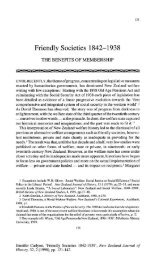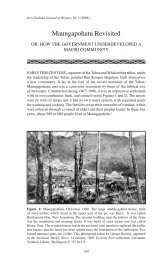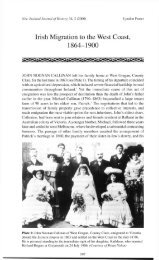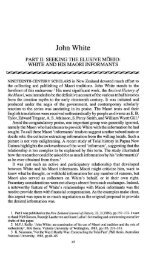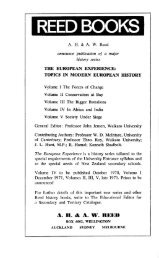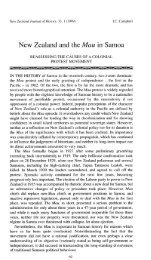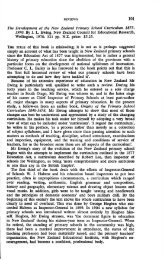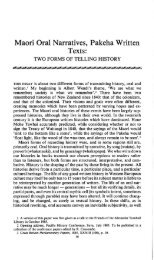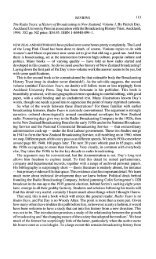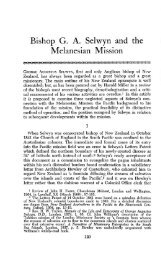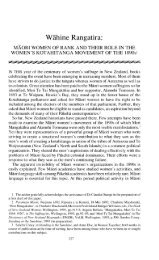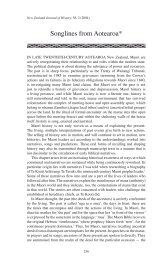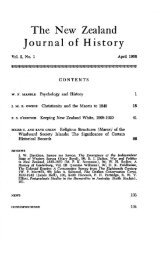'The Ties that Bind' - New Zealand Journal of History
'The Ties that Bind' - New Zealand Journal of History
'The Ties that Bind' - New Zealand Journal of History
Create successful ePaper yourself
Turn your PDF publications into a flip-book with our unique Google optimized e-Paper software.
<strong>'The</strong> <strong>Ties</strong> <strong>that</strong> <strong>Bind'</strong><br />
IRISH CATHOLIC TESTAMENTARY EVIDENCE FROM<br />
CHRISTCHURCH, 1876-1915 1<br />
IRISH CATHOLICS and other migrant groups have received little note from <strong>New</strong><br />
<strong>Zealand</strong> historians, despite the visibility and longevity <strong>of</strong> the institutional<br />
organizations and social networks <strong>that</strong> they created and sustained in this country<br />
during the colonial period. 2 Apart from a few isolated studies, a consciousness<br />
<strong>of</strong> ethnic and religious pluralism has not loomed as large in the writing <strong>of</strong> <strong>New</strong><br />
<strong>Zealand</strong> history as it has in the United States, where immigration historiography<br />
in recent decades has effected a major reorientation away from the assimilating<br />
individual to an emphasis on the enduring group. 3 In general, our scholarship has<br />
not closely examined the forms <strong>of</strong> ethnic culture <strong>that</strong> emerged from the<br />
interaction <strong>of</strong> Old World patterns and the unfamiliar circumstances <strong>of</strong> a new<br />
1 An earlier version <strong>of</strong> this paper was presented at the <strong>New</strong> <strong>Zealand</strong> Historical Association<br />
Conference, Dunedin, 1993.1 am greatly indebted to the critical perspicacity <strong>of</strong> Dr David T. Beito<br />
<strong>of</strong> the University <strong>of</strong> Nevada, Las Vegas, and Dr Maureen E. Montgomery <strong>of</strong> the University' <strong>of</strong><br />
Canterbury.<br />
2 Notable exceptions to this historiographical pattern are Richard P. Davis, Irish Issues in <strong>New</strong><br />
<strong>Zealand</strong> Politics, 1868-1922, Dunedin, 1974; K.A. Pickens, "Canterbury 1851-1881: Demography<br />
and Mobility. A Comparative Study', PhD thesis. Washington University, St. Louis, 1976; Rollo<br />
Arnold, The Farthest Promised Land: English Villagers, <strong>New</strong> <strong>Zealand</strong> Immigrants <strong>of</strong> the 1870s,<br />
Wellington. 1981; Rory Sweetman, <strong>'The</strong> Irish in Nineteenth-Century <strong>New</strong> <strong>Zealand</strong>', in Antonia J.<br />
Jones, ed.. Under The Southern Cross, Hamilton, 1983, pp.266-71; Raewyn Dalziel, 'Emigration<br />
and Kinship: Migrants to <strong>New</strong> Plymouth 1840-1843', <strong>New</strong> <strong>Zealand</strong> <strong>Journal</strong> <strong>of</strong> <strong>History</strong> (NZJH), 25,<br />
2 (1991), pp.112-28. See also. James Ng, Windows on a Chinese Past, Dunedin, 1993; James<br />
Northcote-Bade, ed„ The German Connection: <strong>New</strong> <strong>Zealand</strong> and German-speaking Europe in the<br />
Nineteenth Century, Auckland, 1993. By contrast, there is a rich social science literature on ethnicity<br />
in <strong>New</strong> <strong>Zealand</strong>. It is impossible to list more than a small fraction <strong>of</strong> these studies here, but see the<br />
works cited in Andrew Trlin and Paul Spoonley, eds. <strong>New</strong> <strong>Zealand</strong> International Migration: A Digest<br />
and Bibliography, Palmerston North. 1986-1992. In particular, see K.W. Thompson and A.D. Trlin,<br />
eds, Immigrants in <strong>New</strong> <strong>Zealand</strong>, Palmerston North, 1970; I.H. Burnley, 'German Immigration and<br />
Settlement in <strong>New</strong> <strong>Zealand</strong>, 1842-1914'. <strong>New</strong> <strong>Zealand</strong> Geographer, 29, 1 (1973), pp.45-63; Paul<br />
Spoonley, ed., Tauiwi: Racism and Ethnicity in <strong>New</strong> <strong>Zealand</strong>, Palmerston North. 1984; Maureen<br />
Molloy, 'Kinship, Authority, and Transitions to Adulthood: the Highland Scots at Waipu, <strong>New</strong><br />
<strong>Zealand</strong>, 1854-1914', <strong>Journal</strong> <strong>of</strong> Social <strong>History</strong>, 22, 3 (1989), pp.487-506; David G. Pearson, A<br />
Dream Deferred: The Origins <strong>of</strong> Ethnic Conflict in <strong>New</strong> <strong>Zealand</strong>, Wellington, 1990.<br />
3 Clyde Griffen, 'Towards an Urban Social <strong>History</strong> for <strong>New</strong> <strong>Zealand</strong>', NZJH, 20, 2 (1986),<br />
pp. 111 -31. On the journey 'from process to structure' in American immigration historiography see<br />
Thomas J. Archdeacon, 'Problems and Possibilities in the Study <strong>of</strong> American Immigration and<br />
Ethnic <strong>History</strong>', International Migration Review, 19, 1 (1985), pp.112-34; John Higham, 'From<br />
Process to Structure: Formulations <strong>of</strong> American Immigration <strong>History</strong>', in Peter Kivisto and Dag<br />
Blanck, eds, American Immigrants and Their Generations: Studies and Commentaries on the<br />
Hansen Thesis after Fifty Years, Urbana, 1990, pp. 11 -41.<br />
67
68 LYNDON FRASER<br />
society. Cultural homogeneity, we have assumed, was one <strong>of</strong> the hallmarks <strong>of</strong><br />
white settler society and cultural differences, where they existed, were insignificant<br />
and had no enduring consequences.<br />
In a recent exploratory study <strong>of</strong> the Irish experience in <strong>New</strong> <strong>Zealand</strong>, Donald<br />
Akenson has challenged local historians to recover what they can <strong>of</strong> the world<br />
they have lost and in so doing overcome the cultural amnesia — the collective<br />
memory loss — <strong>that</strong> stands between our time and the past. 4 Lamenting what he<br />
views as the pervasive inwardness <strong>of</strong> <strong>New</strong> <strong>Zealand</strong> historiography, he suggests<br />
<strong>that</strong> its general thrust has paradoxically given extension to a form <strong>of</strong> English<br />
cultural imperialism now quite dead in the British Isles. Akenson concedes <strong>that</strong><br />
white <strong>New</strong> <strong>Zealand</strong>ers eventually produced a national cultural identity during a<br />
long and complex process. But he argues <strong>that</strong> by lumping all white settlers into<br />
a 'spurious unity' we are merely responding to a restrictive bi-cultural dualism<br />
<strong>that</strong> impinges upon a potentially open pluralism and leads to a chronic misreading<br />
<strong>of</strong> nineteenth-century social history. 5 <strong>New</strong> <strong>Zealand</strong> in the past, he claims, was<br />
multi- or poly-cultural, a contention he supports by reference to the persistence<br />
<strong>of</strong> Irish Catholics, who, by refusing to go away, attest to the continuing<br />
significance <strong>of</strong> ethnicity from the mid-nineteenth century to the present. 6<br />
In the concluding chapter to his work, fittingly entitled 'Jobs Undone',<br />
Akenson outlines several approaches and methods, such as collective biographies<br />
and community studies, which would prove useful to researchers investigating<br />
elements <strong>of</strong> the Irish experience in <strong>New</strong> <strong>Zealand</strong>. Viewing ethnicity as<br />
historically consequential, he suggests <strong>that</strong> the concept may provide an indispensable<br />
tool on those occasions where 'a given historical picture, a specific train<br />
<strong>of</strong> events, a complex network <strong>of</strong> affiliations' can be understood only by<br />
introducing it as an explanatory factor. 7 At the very heart <strong>of</strong> his envisioned<br />
research programme, then, is a hope <strong>that</strong> <strong>New</strong> <strong>Zealand</strong> historians will begin to<br />
examine the parameters <strong>of</strong> ethnic history as part <strong>of</strong> a larger programme — the<br />
study <strong>of</strong> demotic culture.<br />
This essay represents an affirmative response to Akenson's clarion call. In the<br />
analysis below, I have attempted to explicate the character and instrumentality<br />
<strong>of</strong> Irish Catholic social ties in Christchurch and its environs, using testamentary<br />
evidence. Although wills originate from a very specific historical situation, they<br />
do allow a researcher to follow multiple lines <strong>of</strong> investigation in the area <strong>of</strong> social<br />
connectedness. 8 To be sure, the social reality <strong>of</strong> historical communities is no<br />
4 Donald H. Akenson, Half The World From Home: Perspectives on the Irish in <strong>New</strong> <strong>Zealand</strong>,<br />
1860-1950, Wellington, 1990.<br />
5 ibid., p.6.<br />
6 ibid., p. 196.<br />
7 ibid., p.203.<br />
8 For examples <strong>of</strong> the use <strong>of</strong> wills in historical research <strong>of</strong> this nature, see Roger T. Vann, 'Wills<br />
And The Family In An English Town: Banbury, 1550-1800', <strong>Journal</strong> <strong>of</strong> Family <strong>History</strong>, 4,4 (1979),<br />
pp.346-67; John E. Crowley, <strong>'The</strong> Importance <strong>of</strong> Kinship: Testamentary Evidence From South<br />
Carolina', <strong>Journal</strong> <strong>of</strong> Interdisciplinary <strong>History</strong> (JIH). 16, 4 (1986), pp.559-77; Daniel Snydacker,<br />
'Kinship and Community in Rural Pennsylvania', JIH, 13, 1 (1982), pp.41-61; Trevor Burnard,<br />
'Inheritance and Independence: Women's status in Early Colonial Jamaica', William and Mars'<br />
Quarterly, 48, 1 (1991), pp.93-114.
'THE TIES THAT BIND' 69<br />
longer accessible directly. In consequence, the enactment <strong>of</strong> social roles within<br />
it can only be inferred through a set <strong>of</strong> mediating documents <strong>that</strong> freeze historical<br />
actors pursuing a singular activity at a given point. Nonetheless, empirical<br />
evidence generated by record linkages between wills and vital events' sources<br />
provide an adequate basis on which to construct a plausible interpretation <strong>of</strong> the<br />
meaning <strong>of</strong> these roles.<br />
A primary focus <strong>of</strong> the ensuing discussion is on ethnicity as a basis <strong>of</strong> social<br />
cohesion and collective action. By ethnicity I understand a dynamic, historical<br />
phenomenon <strong>that</strong> is neither ascribed nor fixed but part <strong>of</strong> a fluid process in which<br />
it is continually reshaped in response to new realities. Ethnicity is a specific type<br />
<strong>of</strong> cultural and social formation, situationally activated and mobilized in the<br />
course <strong>of</strong> daily interaction between immigrants and the host system <strong>of</strong> receiving<br />
societies. And, as such, it constitutes an important resource <strong>of</strong> immense potentiality<br />
<strong>that</strong> is created, sustained and used by social groupings in order to bring<br />
existing circumstances into closer conformity with their own purposes. 9<br />
In this regard, the findings <strong>of</strong> the eminent historian <strong>of</strong> Irish-America, Kerby<br />
Miller, are suggestive <strong>of</strong> one avenue <strong>of</strong> inquiry. Working with a score <strong>of</strong> emigrant<br />
letters, Miller has argued <strong>that</strong> participants in the post-Famine exodus to the<br />
United States were torn in their quest for a sense <strong>of</strong> identity between the<br />
communal ideals <strong>of</strong> the Old World on the one hand and the divergent realities <strong>of</strong><br />
the <strong>New</strong> on the other. It was a dilemma which the Irish resolved creatively<br />
through the establishment <strong>of</strong> patterns <strong>of</strong> social interaction and institutional life<br />
<strong>that</strong> linked both past and present. While familial bonds continued to have crucial<br />
importance, the novel circumstances encountered by immigrants in America<br />
obliged reliance on a wider set <strong>of</strong> highly personal relationships beyond kinship,<br />
based on broadly common characteristics and situations including common<br />
regional origins, neighbourhoods, and work places. These environments not<br />
only acted as sites for ultimate assimilation, but also reinforced practical and<br />
emotional links to Ireland by replicating social networks and cultural patterns<br />
similar to those at home. Despite the ambiguities and tensions inherent in their<br />
position, Irish-Americans made a gradual transition from membership <strong>of</strong> a<br />
neighbourhood society to one based on ethnicity. 10<br />
9 This approach to the multi-generational phenomenon <strong>of</strong> ethnicity is moderately 'situationalist'<br />
in <strong>that</strong> it allows for the combination <strong>of</strong> interests with affective ties. See, for example, Nathan Glazer<br />
and Daniel P. Moynihan. 'Introduction', in Glazer and Moynihan, eds. Ethnicity: Theory and<br />
Experience, Cambridge, Mass.. 1975, pp. 1-26; M. Elaine Burgess, <strong>'The</strong> Resurgence <strong>of</strong> Ethnicity:<br />
Myth or Reality?', Ethnic and Racial Studies (ERS), 1, 3 (1978), pp.265-85; James McKay, 'An<br />
Exploratory Synthesis <strong>of</strong> Primordial and Mobilizationalist Approaches to Ethnic Phenomena', ERS,<br />
5, 4 (1982), pp.395-420; Victor Greene, For God and Country: The Rise <strong>of</strong> Polish and Lithuanian<br />
Ethnic Consciousness in America, 1860-1910, Madison. 1975.<br />
10 Kerby Miller, Emigrants and Exiles: Ireland and the Irish Exodus to North America, <strong>New</strong><br />
York, 1985, pp.520-1, 523. Miller's emphasis on an 'exile mentality', with its connotations <strong>of</strong> a<br />
disintegrating culture, seems to recall the work <strong>of</strong> Oscar Handlin, whose portrait <strong>of</strong> immigrant<br />
peasants received its most vivid expression in his Pulitzer Prize-winning monograph. The Uprooted,<br />
Boston, 1951. My quarrel with this interpretation is <strong>that</strong> it tends to locate sources <strong>of</strong> meanings and<br />
actions outside the conscious volition <strong>of</strong> knowledgeable human subjects. See Lyndon A. Fraser,<br />
'Community, Continuity and Change: Irish Catholic Immigrants in Nineteenth-Century Christchurch',<br />
PhD thesis, University <strong>of</strong> Canterbury, 1993, esp. pp.29-37, 276-79.
70 LYNDON FRASER<br />
It is possible to argue a plausible hypothesis from Miller's interpretation <strong>of</strong><br />
Irish-American patterns <strong>of</strong> association. Whereas Irish Catholics would have<br />
learned early in life to distinguish between 'friends' and strangers, the act <strong>of</strong><br />
emigration and resettlement would have required a constant readjustment,<br />
alteration and revision <strong>of</strong> <strong>that</strong> terminology and its meaning in a new environment.<br />
This process <strong>of</strong> realignment would in turn have irreparably changed the<br />
associative universe <strong>of</strong> the emigrants, which was never static, but continually<br />
expanding and contracting according to local conditions or the dictates <strong>of</strong> the life<br />
cycle and its assorted demographic variables. It makes good intuitive sense to<br />
conjecture <strong>that</strong> in Canterbury, as in the United States, these circumstances<br />
promoted and reinforced personal ethnic networks. If the decision-making <strong>of</strong><br />
testators, for example, reveals <strong>that</strong> Irish Catholics co-operated more with one<br />
another than with outsiders, then the totality <strong>of</strong> socially used links surely<br />
indicates the existence <strong>of</strong> group social behaviour along ethnic lines. Conversely,<br />
where shallow sets <strong>of</strong> ethnic ties are found then the hypothesis must be rejected<br />
on the grounds <strong>that</strong> socio-economic conditions in the receiving society were not<br />
conducive to the development <strong>of</strong> ethnic consciousness.<br />
The analysis <strong>of</strong> ethnic bonding need not close <strong>of</strong>f other lines <strong>of</strong> investigation<br />
which can be pursued simultaneously. In particular, testamentary evidence is<br />
useful in explicating the meaning <strong>of</strong> a range <strong>of</strong> structural relationships such as<br />
<strong>that</strong> between kinfolk, or within the conjugal family, where clues to the position<br />
<strong>of</strong> women in Irish-<strong>New</strong> <strong>Zealand</strong> families are embedded. It would be foolish to<br />
ignore the fact <strong>that</strong> historical actors played multiple social roles during their lives<br />
— as spouses, siblings, godparents, communicants and so on. To do justice to the<br />
depth and complexity <strong>of</strong> the immigrant experience each must be included for<br />
consideration. Indeed, these additional structural elements may tell us a great<br />
deal more about the survival <strong>of</strong> aspects <strong>of</strong> transposed cultural resources than<br />
hitherto suspected. Whatever the case, it ensures <strong>that</strong> our discussion is considerably<br />
enlarged. My objective, therefore, is not simply to establish whether the<br />
relationship between a testator and the beneficiaries <strong>of</strong> a will was ethnic in<br />
character. It is also to ask whether kinship for Irish Catholic immigrants implied<br />
only the conjugal family unit or whether it entailed the recognition <strong>of</strong> a wider<br />
range <strong>of</strong> kin. What did it mean to be a spouse, uncle, sibling or other in-law in<br />
an ethno-religious community <strong>of</strong> this type? Did Irish husbands entrust their<br />
wives with considerable powers <strong>of</strong> management with regard to the disposal <strong>of</strong><br />
their estates? What constructions can be placed upon the ways in which people<br />
within this community organized their social world?<br />
To address these issues, I collected social data from the wills <strong>of</strong> all Irish<br />
Catholic adults dying between the years 1876 and 1915 registered at Christchurch.<br />
The resulting sample comprised a total <strong>of</strong> 178 documents <strong>of</strong> which 117 were left<br />
by men, including 21 prepared by unmarried testators, while a further 61<br />
belonged to women, <strong>of</strong> whom only six were spinsters. It is unlikely <strong>that</strong> those<br />
who made wills were truly representative <strong>of</strong> the majority <strong>of</strong> Irish Catholic<br />
decedents but testators probably represented a broader range <strong>of</strong> the social order<br />
<strong>of</strong> Irish migrant communities than letter writers, whose descriptions <strong>of</strong> life in
'THE TIES THAT BIND' 71<br />
exile have been the basis <strong>of</strong> several major studies." Illiterates, for example, who<br />
had few chances to leave written documents to posterity, constituted a significant<br />
minority <strong>of</strong> testators. Among males the proportion <strong>of</strong> those who were unable to<br />
provide a signature was over one-third (36.8 percent), compared to more than<br />
two-fifths <strong>of</strong> women (42.6 percent). Nonetheless, the sample is skewed toward<br />
the more well-to-do in terms <strong>of</strong> its occupational distribution when contrasted<br />
with all Irish Catholic decedents whose deaths were recorded during the period<br />
under consideration. Rather than according undue primacy to the value <strong>of</strong> wills<br />
in historical research, therefore, we should reconceptualize testamentary activity<br />
as one particular form <strong>of</strong> interaction which indicates the system <strong>of</strong> social<br />
relations operating among Catholic Irish immigrants in the city. Proceeding<br />
upon this assumption, we can begin to examine the content <strong>of</strong> the testamentary<br />
evidence.<br />
One <strong>of</strong> the most difficult tasks facing a person making a will was the choice<br />
<strong>of</strong> suitable executors who could be relied upon to administer their estate and carry<br />
out the wishes expressed in their testament. The final resolution <strong>of</strong> this question<br />
in favour <strong>of</strong> certain named individuals clearly implies <strong>that</strong> there was a great deal<br />
<strong>of</strong> trust on the part <strong>of</strong> a testator toward those selected. A lack <strong>of</strong> recognition<br />
toward others whom one might have expected to have been entrusted with this<br />
duty suggests <strong>that</strong> they were thought less capable <strong>of</strong> managing the deceased's<br />
worldly affairs.<br />
This last point has special significance in relation to married Irish Catholic<br />
males, who seem to have been remarkably unwilling to appoint their widows as<br />
executors <strong>of</strong> their estates (see Table 1). Of 76 men dying between 1876 and 1915<br />
who were survived by a spouse, only 39.5% considered their wives qualified to<br />
settle their affairs. Among this group poorer, childless testators, such as the<br />
labourers Lawrence McMahon 12 and Michael Joseph Ryan, 11 displayed a greater<br />
propensity to repose unfettered management powers in their widows. 14 On the<br />
other hand smaller numbers <strong>of</strong> testators created joint executorships whereby<br />
wives were named alongside other individuals, a preference <strong>that</strong> favoured both<br />
kin and Catholic non-kin equally. Tipperary-born Patrick O'Neill <strong>of</strong> Camside,<br />
for example, designated his friends Michael Lynskey and John Daley as trustees<br />
<strong>of</strong> his estate together with his wife, Catherine," while the railway ganger, James<br />
Doherty, bestowed the responsibility upon his spouse and his only son jointly. 16<br />
11 See, for example. Miller, passim; David Fitzpatrick, '"That Beloved Country, <strong>that</strong> No Place<br />
Else Resembles": Connotations <strong>of</strong> Irishness in Irish-Australasian letters, 1841-1915', Irish Historical<br />
Studies, 27, 108 (1991), pp.324-51.<br />
12 The Will <strong>of</strong> Lawrence McMahon, 10293/1919, National Archives, Christchurch (NA-CH);<br />
Death Index, 751/1915.<br />
13 The Will <strong>of</strong> Michael J. Ryan, 6131/1907, NA-CH; Death Index, 992/1907.<br />
14 Altogether 53.8% <strong>of</strong> childless testators entrusted their wives with sole powers <strong>of</strong> management<br />
<strong>of</strong> their estate, while 30.8% excluded them entirely. Whilst the small number <strong>of</strong> testators <strong>of</strong> this type<br />
(N= 13) means <strong>that</strong> we must treat these results with a degree <strong>of</strong> scepticism, they do match patterns<br />
revealed in other studies. See, for example, Burnard, Table 3, p. 102.<br />
15 The Will <strong>of</strong> Patrick O'Neill, 4592/1902, NA-CH; Death Index, 777/1902.<br />
16 The Will <strong>of</strong> James Doherty, 8846/1915, NA-CH; Death Index. 494/1915.
72 LYNDON FRASER<br />
Table 1. Executors named in the Wills <strong>of</strong> Married Irish Catholic Males,<br />
1876-1915<br />
Executors N %<br />
Wife Alone 30 39.5<br />
Wife and Kin 7 9.2<br />
Wife and Other 7 9.2<br />
Wife Excluded 32 42.1<br />
Totals 76 100.0<br />
Sources: Christchurch Registry <strong>of</strong> Births, Deaths and Marriages; Probate Files, CH 171, National<br />
Archives, Christchurch.<br />
Note: The number <strong>of</strong> cases where non-kin werejoined with the widows <strong>of</strong> testators in exercising the<br />
duty <strong>of</strong> executorship have been placed in the category. 'Wife and Other'. It is significant <strong>that</strong> in all<br />
<strong>of</strong> these instances the persons appointed were Roman Catholics.<br />
An unusually large proportion <strong>of</strong> testators chose to exclude their wives from<br />
the role altogether (42.1%), indicating <strong>that</strong> these men had a little confidence in<br />
the business acumen <strong>of</strong> their partners. Of these wills 34.3% named Irish Catholic<br />
friends as sole executors, 40.6% appointed kinfolk and 9.4% expressed a<br />
preference for a combination <strong>of</strong> the two categories. A further 9.4% named non-<br />
Irish Catholics as executors, a decision which represented a limited widening <strong>of</strong><br />
the ethnic domain to include outsiders <strong>of</strong> the same religious persuasion. 17 Only<br />
a single testament, <strong>that</strong> <strong>of</strong> the ex-policeman Daniel Flanagan, appointed a non-<br />
Catholic executorship and in this case both <strong>of</strong> the men named renounced the role,<br />
compelling his widow, Anastasia, to apply for a grant <strong>of</strong> letters <strong>of</strong> administration<br />
to his estate. 18<br />
Unfortunately very few married women who were survived by a husband left<br />
wills to posterity, but for those who did there appears to have been little<br />
inducement to name spouses as trustees. Altogether only one-quarter <strong>of</strong> female<br />
testators chose to entrust their estates with their husbands alone (26.3%),<br />
whereas a majority elected to exclude them entirely from this role (57.9%).<br />
Significantly, the subsequent choices <strong>of</strong> this latter group reflected <strong>that</strong> <strong>of</strong> married<br />
men in their preference for either kinfolk or Catholic friends. Alice Leonard, for<br />
example, appointed her brother Christopher O'Neill <strong>of</strong> Makikihi to settle her<br />
17 Patrick Donnelly <strong>of</strong> County Tyrone, for example, named the English furniture dealer, Alfred<br />
Joseph White, and the German bootmaker, Daniel Steinmetz, as joint trustees <strong>of</strong> his estate. They were<br />
instructed not to sell his house and property at St. Asaph Street without the written consent <strong>of</strong> his<br />
second wife, Catherine Canavan, who was entitled to occupation rent free until her decease or<br />
subsequent remarriage, when the estate would revert to all his children in equal shares. The Will <strong>of</strong><br />
Patrick Donnelly, 1668/1888 NA-CH; Death Index, 593/1888; Birth Index, 1715/1878, 1603/1881.<br />
1125/1883, 999/1885, and 391/1888.<br />
18 The Will <strong>of</strong> Daniel Flanagan, 4726/1903, NA-CH; Death Index. 801/1902.
'THE TIES THAT BIND' 73<br />
affairs,' 9 while Jane Broad named local storekeeper and commission agent,<br />
Michael Dineen, as the sole executor <strong>of</strong> her estate. 20 Although the number <strong>of</strong><br />
existing testaments (20) is not large enough to permit more than tentative<br />
conclusions being drawn, the choices <strong>of</strong> these women raises the intriguing<br />
possibility <strong>that</strong> the lack <strong>of</strong> confidence expressed by Irish Catholic husbands in<br />
the ability <strong>of</strong> their wives to manage their estates was more than reciprocated<br />
toward male spouses by Irish wives. Some support for this view can be gleaned<br />
from the disposition <strong>of</strong> property by married women, a subject <strong>that</strong> will be dealt<br />
with later in this essay.<br />
The executorships created by single and widowed adults are <strong>of</strong> a very different<br />
nature from those listed above because the opportunity to name a spouse has been<br />
foreclosed. Nonetheless, their testamentary choices reflect a similar reliance on<br />
social ties within the ethnic community (see Table 2). Testators who were<br />
widows or widowers frequently called upon kin to act as trustees, a tendency <strong>that</strong><br />
was not unexpected given the wider context <strong>of</strong> their kinship domain. In most<br />
cases these executors were members <strong>of</strong> the testator's immediate family, usually<br />
but not exclusively males, and <strong>of</strong>ten co-resident with the deceased. Catherine<br />
Owens, for instance, who had emigrated to Canterbury aboard the Northhampton<br />
in 1874, appointed her youngest son, Thomas, with whom she was residing in<br />
Horatio Street, as sole trustee <strong>of</strong> her estate. 21 Catherine Burrows, on the other<br />
hand, was resident with her daughter, Mary, in Opawa at the time <strong>of</strong> her death<br />
but chose her son, Samuel, as executor. 22 In a small number <strong>of</strong> testaments<br />
secondary kinship ties were actively engaged, as was the case in the will <strong>of</strong><br />
William Shea, which gave the role to a son-in-law, 23 and Margaret Bruns, who<br />
named a nephew, Thomas Sheehan. 24 A far greater reliance was placed upon Irish<br />
Catholic non-kin than relatives whose consanguinity extended beyond the<br />
primary variety. Some 17.6% <strong>of</strong> widows and 16.7% <strong>of</strong> widowers named Irish<br />
Catholic friends as executors, a level <strong>of</strong> recognition which is heightened when<br />
one considers <strong>that</strong> an additional one-tenth <strong>of</strong> the appointments <strong>of</strong> both groups<br />
featured the latter in joint partnership with kinfolk. 25<br />
19 The Will <strong>of</strong> Alice Leonard, 5762/1906, NA-CH; Death Index, 767/1906.<br />
20 The Will <strong>of</strong> Jane Broad, 6779/1909, NA-CH; Death Index, 730/1909.<br />
21 The Will <strong>of</strong> Catherine Owens, 8337/1914, NA-CH; Death Index, 648/1914.<br />
22 The Will <strong>of</strong> Catherine Burrows, 7643/1912, NA-CH; The Will <strong>of</strong> Samuel Burrows, 5833/<br />
1907, NA-CH; Death Index, 410/1912 and 182/1907.<br />
23 The Will <strong>of</strong> William Shea. 7177/1911, NA-CH; Death Index, 23/1911.<br />
24 The Will <strong>of</strong> Margaret Bruns, 8654/1915, NA-CH; Death Index, 507/1915.<br />
25 See, forexample, The Will <strong>of</strong> Margaret Donnelly, 3896/1900, NA-CH; Death Index. 463/1885<br />
and 191/1900; Birth Index. 441/1877. Margaret Harvey married Hugh Donnelly in Berragh, County<br />
Tyrone, on 18 September 1870. Hugh died intestate in 1885, leaving behind a large family for<br />
Margaret to nurture. Prior to her own death in 1900 she prepared a will in which she named her son,<br />
Edward, and a friend, John Glackin, as executors.
74 LYNDON FRASER<br />
Table 2. Executors named in Wills <strong>of</strong> Single and Widowed Irish Catholic<br />
Testators by Percent, 1876-1915<br />
Testators Kin Irish Non- Irish and Other Non-<br />
Alone Kin Kin Catholic Catholic<br />
Widowers 72.2 16.7 11.1 0.0 0.0<br />
W=18)<br />
Single Men 15.0 65.0 5.0 15.0 5.0<br />
(N= 20)<br />
Widows 64.7 17.6 11.8 5.9 0.0<br />
W=34)<br />
Single Women 50.0 33.3 0.0 16.7 0.0<br />
(N=6)<br />
Totals 52.6 30.8 9.0 6.4 1.3<br />
(N= 78)<br />
Sources: As Table 1.<br />
Note: The residual category entitled 'Other Catholic' includes cases where non-Irish Catholics were<br />
named jointly with kin or Irish Catholics, or where the latter were appointed alongside non-Catholics.<br />
Table 3. Extension <strong>of</strong> Bequests beyond Primary Kinship <strong>Ties</strong>, 1876-1915<br />
Testators To Nephews To Other To To<br />
and Nieces Kinsfolk Friends Church<br />
Married men 6.4 3.8 2.6 10.3<br />
Widowers 5.6 0.0 16.6 22.2<br />
Single Men 22.7 9.1 27.3 50.0<br />
Married women 10.0 15.0 5.0 40.0<br />
Widows 8.6 8.6 5.7 20.0<br />
Single women 16.6 16.6 16.6 66.6<br />
Totals 9.5 6.7 8.4 23.5<br />
Sources: As Table 1.<br />
Kinship ties were also an extremely important influence in shaping the ways<br />
<strong>that</strong> single adults designated their executors. However, there was a clear<br />
tendency to use ethnic networks where necessary, especially among single men.<br />
When Terence McHugh <strong>of</strong> Conougher, County Galway, prepared his will in<br />
Timaru in 1904 he named a priest, Father John Tubman, as did a labourer, Patrick<br />
McGrath, who named Father Michael O'Boyle as his sole trustee. 26 Neighbours<br />
were also likely to be called upon to assume this responsibility, a pattern reflected<br />
26 The Will <strong>of</strong> Terence McHugh, 7229/1911, NA-CH; Death Index, 122/1911; The Will <strong>of</strong><br />
Patrick McGrath, 7849/1913, NA-CH; Death Index, 96/1913.
'THE TIES THAT BIND' 75<br />
in the wills <strong>of</strong> John Reilly, Michael Burns and Jeremiah Hogan. 27 Others, such<br />
as John Robbie O'Brien and James Lawlor, chose Irishmen with whom they<br />
appear to have been well acquainted, 28 while Patrick Lynch named his brother,<br />
Owen, and two Irish Catholic farmers, Hugh Gillon and Patrick Brown, to settle<br />
his affairs. 29 Overall, the data for single adults confirms the general impression<br />
<strong>of</strong> the wills <strong>of</strong> their married counterparts in their consistent proclivity for the<br />
construction <strong>of</strong> boundaries beyond which few social relations were extended.<br />
Rather than indicating a dearth <strong>of</strong> kinship obligations or weak associational<br />
bonding, this evidence is strongly suggestive <strong>of</strong> exclusive networks <strong>of</strong> mutuality<br />
<strong>that</strong> were based upon ethnic and kinship ties.<br />
The overriding concern <strong>of</strong> those who left wills was undoubtedly the final<br />
disposition <strong>of</strong> their worldly property. This decision required a testator to balance<br />
a number <strong>of</strong> competing interests. Married men, for example, had not only to<br />
consider the future welfare <strong>of</strong> their wives in their testamentary activities, but also<br />
<strong>that</strong> <strong>of</strong> their children. They had to choose between entrusting their spouses with<br />
complete powers <strong>of</strong> disposal over their estate, or, while providing for their<br />
security, curtailing their economic authority so as to prevent them from alienating<br />
the trust property. In the same way, they needed to determine whether they<br />
should divest bequests made in favour <strong>of</strong> their wives upon their remarriage. Such<br />
preliminary questions, if applicable, were no doubt followed by careful deliberation<br />
over the size <strong>of</strong> the shares to be given to each <strong>of</strong> the surviving children,<br />
whether the residue <strong>of</strong> the estate should be devised upon sons, and what provision<br />
to make for unmarried daughters.<br />
The testamentary priorities <strong>of</strong> childless, unmarried, and widowed decedents<br />
varied quite considerably from their married counterparts in the disposition <strong>of</strong><br />
property and in relations with those who had legitimate claims on their estates.<br />
While questions relating to the inheritance <strong>of</strong> children were still relevant for most<br />
widowed testators, this was usually not so for single adults, who were able to<br />
enact different bequesting practices. The latter group did not have the same<br />
concerns as married and widowed testators and sometimes found it easier to<br />
leave a few pounds aside for masses. It is clear, therefore, each <strong>of</strong> these<br />
conditions is unique and analyzable separately. The most sensible approach<br />
would be to ascertain the specific type <strong>of</strong> inheritance patterns revealed by<br />
disposition <strong>of</strong> the residue, moving thereafter to a discussion <strong>of</strong> the extension <strong>of</strong><br />
bequests beyond the immediate family.<br />
The wills <strong>of</strong> married men and widowers demonstrated a wide variety <strong>of</strong><br />
methods for dealing with the transmission <strong>of</strong> residual property. A majority <strong>of</strong><br />
testators expressed a preference for impartible inheritance (58.3%), much as they<br />
27 The Will <strong>of</strong> John Reilly, 7745/1912, NA-CH; Death Index. 699/1912; The Will <strong>of</strong> Michael<br />
Burns, 4268/1901, NA-CH; Death Index, 289/1901; The Will <strong>of</strong> Jeremiah Hogan. 3945/1900, NA-<br />
CH; Death Index, 193/1900.<br />
28 The Will <strong>of</strong> John Robbie O'Brien, 4430/1902, NA-CH; Death Index, 360/1902; The Will <strong>of</strong><br />
James Casson Lawlor, 2949/1895, NA-CH; Death Index, 476/1895.<br />
29 The Will <strong>of</strong> Patrick John Lynch, 2334/1892. NA-CH; Death Index, 512/1892.
76 LYNDON FRASER<br />
would have done in Ireland. A considerably smaller proportion chose to divide<br />
their property equally (18.8%), while the remainder (22.9%) elected to establish<br />
some form <strong>of</strong> joint partnership where at least one child was excluded from a share<br />
in the estate. Overall, the testaments failed to demonstrate any clear bias in the<br />
direction <strong>of</strong> either ultimogeniture or primogeniture, but a significant minority<br />
favoured sons over daughters in the division <strong>of</strong> property (40.0%). 30<br />
The testaments <strong>of</strong> married men with surviving spouses disclosed a distinctive<br />
mode <strong>of</strong> inheritance. Just as these testators had been reluctant to appoint their<br />
partners as executors <strong>of</strong> their estates, so too were they unwilling to grant<br />
extensive powers <strong>of</strong> disposal over their property to their wives. This reticence<br />
was reflected in the fact <strong>that</strong> 37.2% <strong>of</strong> male testators transferred the residuary<br />
interest in their estates to their spouses absolutely, an abysmally low figure<br />
which reveals a great deal about prevailing attitudes toward female economic<br />
independence. Interestingly, both men without children (61.5%) and those<br />
employed in blue collar occupations (54.8%) were more likely to entrust their<br />
wives with unfettered control <strong>of</strong> their property than proprietors (22.6%). Farmers<br />
were particularly disinclined to settle their property in this manner and it was<br />
uncommon for their wills to give absolute disposing power over an estate to a<br />
spouse (20.6%).<br />
The majority <strong>of</strong> married men sought to restrict the control <strong>of</strong> wives over their<br />
property and employed several testamentary devices to enable them to do so. Of<br />
these methods the creation <strong>of</strong> a life-interest (37.2%) was clearly the most popular<br />
strategy. The will <strong>of</strong> Francis McCleary <strong>of</strong> Dunsandel is a splendid example <strong>of</strong><br />
this form <strong>of</strong> disposition and noteworthy for the manner in which it favours a male<br />
heir over the claims <strong>of</strong> daughters. McCleary, a farmer, named his only son,<br />
James, and a friend, Patrick McCartin <strong>of</strong> Southbridge, as the joint executors <strong>of</strong><br />
his estate. He instructed <strong>that</strong> his wife be allowed to use the farm and its stock for<br />
her benefit during her lifetime and after her death the property, together with the<br />
stock, crop, and all other belongings was to repose in his son 'provided <strong>that</strong> he<br />
pays £ 100 (one hundred pounds) to each <strong>of</strong> his sisters Elizabeth, Mary and Ellen'.<br />
Perhaps suspecting his son might be unenthusiastic about parting with hard cash<br />
and refuse to carry out the arrangement, McCleary instructed <strong>that</strong> the land was<br />
to be sold and the proceeds divided into six parts: 'three sixths I bequeath to my<br />
son James, and one sixth to each <strong>of</strong> my daughters aforementioned'. 31 Similarly,<br />
Daniel McVeigh <strong>of</strong> Shands Track bequeathed all his estate to his wife. Rose, for<br />
life, as well as a sum <strong>of</strong> £250 owed to him by his second son, James, which he<br />
now instructed him to pay to his mother. After her death the estate was to pass<br />
to McVeigh's eldest son, Daniel, who was to pay the sum <strong>of</strong> £ 100 to his younger<br />
brother provided he had repaid this outstanding debt. Furthermore, McVeigh<br />
stipulated, he 'shall also pay to my three daughters Rose, Margaret and Catherine,<br />
five pounds (£5.0s.0d.) each; to my daughter Mary, fifteen pounds (£15.0s.0d.)<br />
30 On these inheritance practices, see Cormac O. Grada, 'Primogeniture and Ultimogeniture in<br />
Rural Ireland', <strong>Journal</strong> <strong>of</strong> Interdisciplinary <strong>History</strong>, 10, (1980), pp.491-98.<br />
31 The Will <strong>of</strong> Francis McCleary, 5235/1905, NA-CH; Death Index, 121/1905.
'THE TIES THAT BIND' 77<br />
and to the two other daughters, Elizabeth and Sarah, twenty pounds (£20.0s.0d.)<br />
each'. 12<br />
Annuities were another testamentary device favoured by married men, but<br />
these required some form <strong>of</strong> fixed capital to establish successfully. Michael<br />
Power <strong>of</strong> Ohoka, for instance, elected this option for the benefit <strong>of</strong> his wife,<br />
Mary, after which the residuary interest was to be divided between five <strong>of</strong> his<br />
sons. 11 Timothy Slattery, on the other hand, instructed <strong>that</strong> the residue <strong>of</strong> his<br />
estate was to be divided into four portions immediately following his own death,<br />
three <strong>of</strong> which were to go equally to his sons, while one was to be invested and<br />
the interest used for the maintenance <strong>of</strong> his wife, Johanna, during her lifetime. 34<br />
There was always a danger <strong>that</strong> the amount a testator left aside for his spouse<br />
would be wholly insufficient to meet her daily needs. Such was the case for Alice<br />
Tobin, whose husband, James, left her an annuity <strong>of</strong> £65 to be paid in quarterly<br />
instalments. Afflicted with rheumatism and other maladies, Alice Tobin could<br />
do little toward her own support. In consequence, she was forced to lodge a<br />
petition for relief in the Supreme Court. She maintained <strong>that</strong> at the time <strong>of</strong> her<br />
marriage she possessed a sum <strong>of</strong> £100 which she gave to her spouse 'for the<br />
purpose <strong>of</strong> his farming operations and for [the] purchase <strong>of</strong> land'. By contrast,<br />
James Tobin only held property to the value <strong>of</strong> £10. Moreover, she claimed to<br />
have lived with her husband continuously, except during his brief confinement<br />
in the Sunnyside Asylum, and had 'assisted in the making <strong>of</strong> the property <strong>of</strong><br />
which he died possessed'. 35 While the circumstances surrounding this case were<br />
unique, the testimony <strong>of</strong> Alice Tobin reminds us <strong>of</strong> the unpaid contribution <strong>that</strong><br />
Irish wives made to their families and underlines the extent to which testamentary<br />
dispositions sometimes gave minimal recognition to their efforts.<br />
The wills <strong>of</strong> the remaining testators set out various mechanisms to deal with<br />
the claims <strong>of</strong> widows. In a lengthy document, Laurence Kirwan bestowed an<br />
outright gift <strong>of</strong> £1000 on his third wife, Elizabeth, and granted her the use <strong>of</strong> a<br />
property situated at Montreal Street. 36 The will <strong>of</strong> John Kelly was rather more<br />
ambiguous. After devising all his land to his eldest son, John, he granted 40 acres<br />
to the latter's younger sibling, Connor. However, this bequest was subject to his<br />
mother having the use <strong>of</strong> the same until he turned 21 'until which time he cannot<br />
bring any one on the property without her consent'. Kelly expressed a desire <strong>that</strong><br />
his three children should live together with their mother 'should it be agreeable<br />
to them to do so'. But he stipulated <strong>that</strong> if at the age <strong>of</strong> 21 Connor instructed his<br />
32 The Will <strong>of</strong> Daniel McVeigh, 2114/1891, NA-CH; Death Index, 250/1891. McVeigh named<br />
Michael Francis Ryan, farmer, <strong>of</strong> Broadfields and James Doherty, labourer, <strong>of</strong> Lincoln as the<br />
executors <strong>of</strong> his estate.<br />
33 Power, <strong>of</strong> County Waterford, was accompanied by his wife, Mary [Nolan], and their infant<br />
son, John, on the voyage out aboard the Sebastopol in 1861. The Will <strong>of</strong> Michael Power, 2226/1892<br />
NA; Death Index 65/1892; Im-CH 4/36, NA-W.<br />
34 The Will <strong>of</strong> Timothy Slattery, 7891/1913, NA-CH; Death Index, 223/1913.<br />
35 The Will <strong>of</strong> James Tobin, 4611/1902, NA-CH; Death Index, 863/1902. Mr Justice Denniston<br />
raised the level <strong>of</strong> her annuity to £90 per annum in accordance with a recommendation by the<br />
secretary <strong>of</strong> the Charitable Aid Board, Thomas Norris.<br />
36 The Will <strong>of</strong> Laurence Kirwan. 6887/1910, NA-CH; Death Index, 136/1910.
78 LYNDON FRASER<br />
mother and sister to leave, or they chose to do so <strong>of</strong> their own accord, then 'he<br />
shall give to each the sum <strong>of</strong> twenty pounds sterling.' 37 One testator, a bootmaker,<br />
Michael Mahoney, failed to even mention his wife in his testamentary provisions,<br />
18 while the obligation <strong>of</strong> John Fay's surviving children to his widow was<br />
merely implicit in the text. 19<br />
A small but significant minority <strong>of</strong> married men attempted to exert some<br />
control over their wives' re-marriage from beyond the grave through the<br />
divestment or reduction <strong>of</strong> their share in the residue <strong>of</strong> their estate. Austin<br />
Tarpey, for example, granted his wife, Sarah, an annuity from his estate 'so long<br />
as she shall continue my widow' and stipulated <strong>that</strong> she was to have no power<br />
to anticipate or alienate his property. 40 Similarly, the residuary interest <strong>of</strong> Ellen<br />
Roach in the estate <strong>of</strong> her husband, Thomas, and the role as joint guardian <strong>of</strong> the<br />
couple's child was contingent upon her remaining a widow. 41 In an interesting<br />
provision, common to a number <strong>of</strong> wills, Roach's testament stated <strong>that</strong> the<br />
residuary share would revert to his daughter, Margaret, at the age <strong>of</strong> 21 years, but<br />
if she married 'for her sole and separate use and at all times freed from marital<br />
control'. 42 This type <strong>of</strong> testamentary disposition is more consistent with those<br />
specifying restrictions on remarriage than it might at first seem, for it represented<br />
a means to prevent male non-kin linked conjugally to surviving female kinfolk<br />
meddling with the family estate. In seeking to protect their property by methods<br />
<strong>that</strong> severely limited the authority <strong>of</strong> their wives, these men sometimes exercised<br />
their patriarchal authority in such a way as to extend greater powers <strong>of</strong><br />
management to their daughters.<br />
The pattern <strong>of</strong> inheritance disclosed by the testamentary preferences <strong>of</strong><br />
married and widowed men is inconsistent with interpretations <strong>that</strong> equate the<br />
decision to emigrate with a willingness to depart from traditional expectations. 43<br />
Clearly, the social roles enacted by many first-generation immigrant women<br />
37 The Will <strong>of</strong> John Kelly. 247/1878, NA-CH; Death Index, 479/1878.<br />
38 The Will <strong>of</strong> Michael Mahoney, 1369/1887, NA-CH; Death Index, 70/1887; Birth Index, 189/<br />
1878 and 1446/1881.<br />
39 John Fay appointed his wife, Anne Doyle, and two <strong>of</strong> his sons, James and Joseph Michael, as<br />
trustees and executors <strong>of</strong> his estate from which they were to take all his household furniture and<br />
effects and divide them among themselves. He bequeathed the sum <strong>of</strong> £500 to his only daughter,<br />
Mary Ann, on attaining 24 years <strong>of</strong> age, and a lesser sum <strong>of</strong> £150 to his son Patrick. All his 'various<br />
properties' were to be divided among his other three sons, James, Joseph Michael and Anthony, while<br />
a friend, Peter McEvedy <strong>of</strong> Southbridge, was to fulfil a role as 'advisor' <strong>of</strong> his estate. The Will <strong>of</strong> John<br />
Fay, 3248/1897 NA-CH; Death Index. 204/1897.<br />
40 When the designated executors, Alfred Joseph White and Andrew Loughnan, renounced their<br />
role, Sarah Tarpey was compelled to apply for a grant <strong>of</strong> letters <strong>of</strong> administration to the estate <strong>of</strong> her<br />
late husband. The Will <strong>of</strong> Austin Tarpey, 732/1882; Death Index, 391/1881.<br />
41 The Will <strong>of</strong> Thomas Roach, 3548/1898, NA-CH; Death Index, 442/1898.<br />
42 ibid.; Roach's testament further stipulated <strong>that</strong> should Margaret die without leaving heirs then<br />
the residuary share was to go to his grand-daughter, Mary Margaret Wilson <strong>of</strong> <strong>New</strong> South Wales,<br />
'free from marital control'.<br />
43 The power and status <strong>of</strong> women in Irish society during the nineteenth century is a subject <strong>of</strong><br />
considerable debate. For example, see Joanna Bourke, '"The Best <strong>of</strong> All Home Rulers"; The<br />
Economic Power <strong>of</strong> Women in Ireland, 1880-1914', Irish Economic and Social <strong>History</strong>, 18, (1991).<br />
pp.34-47.
'THE TIES THAT BIND' 79<br />
were as likely to have remained restrictive in the colony, for the wills <strong>of</strong> their<br />
husbands effectively denied them a controlling interest in property to which they<br />
had made a substantial contribution. Nonetheless, Irish wives were unwilling to<br />
submit entirely to the domination <strong>of</strong> their husbands. Only 20.0% <strong>of</strong> married<br />
women entrusted their property to their spouses absolutely, a figure <strong>that</strong> is<br />
consistent with their reluctance to name husbands as executors <strong>of</strong> their estates.<br />
While it is difficult to determine the precise significance <strong>of</strong> this state <strong>of</strong> affairs,<br />
it does seem to indicate a reassertion <strong>of</strong> lineal family values. However, such<br />
evidence also discloses unresolved marital conflicts and demands a rather<br />
pessimistic assessment <strong>of</strong> the situation in which married Irish female immigrants<br />
found themselves. By choosing marriage and all <strong>that</strong> it entailed, they also chose<br />
a tradition which made their own material interests secondary. It was one <strong>that</strong><br />
possibly guaranteed economic security, but not an equitable exercise <strong>of</strong> economic<br />
authority. In their own testaments, married women expressed resistance<br />
toward the patriarchal authority <strong>of</strong> their husbands. But ironically, many strengthened<br />
the hold <strong>of</strong> patriarchy over a future generation <strong>of</strong> women through favouring<br />
sons over daughters in assigning the residuary interest <strong>of</strong> their estates (47.8%).<br />
The gender and marital status <strong>of</strong> Irish Catholic testators had a decisive bearing<br />
on the frequency with which they recognized individuals and structures outside<br />
their own household (see Table 3). In general, women willed bequests to distant<br />
kinfolk with greater frequency than men and expressed their religiosity more<br />
resolutely in terms <strong>of</strong> their testamentary dispositions. Susan O'Boyle <strong>of</strong> County<br />
Antrim, for example, combined both <strong>of</strong> these concerns in the provisions <strong>of</strong> her<br />
will. She devised all her land and personal effects upon a favoured niece, Susan<br />
Morgan, and instructed her executor, Patrick O'Connor, to charge the remainder<br />
<strong>of</strong> her estate with a series <strong>of</strong> endowments. He was first to apply £60 for the<br />
erection <strong>of</strong> two headstones and railings for O'Boyle and her late husband,<br />
Francis, at Leeston, and to use a further £20 to secure the same for her late<br />
brother, Alexander McCloy. After £30 had been expended for the purpose <strong>of</strong><br />
procuring masses for the repose <strong>of</strong> her soul, £ 100 each were to accrue to her sister<br />
Sarah Morgan and niece, Elizabeth Morgan, both <strong>of</strong> Ireland. An additional £150<br />
was set aside for two nephews and three other nieces from the same family. 44 She<br />
devised lesser sums upon her sister-in-law, Margaret McCloy (£90), the wife <strong>of</strong><br />
her late brother, and their three children (£90 each), her niece, Ann Probyn (£90),<br />
and another sister, Jane Willis (£50) 45<br />
The will <strong>of</strong> a Galway-born widow, Mary Walsh, was less typical. Her<br />
testament generously bequeathed proceeds <strong>of</strong> the sale <strong>of</strong> her properties situated<br />
in Essex and Clothier streets to the Mother Superior <strong>of</strong> the Notre Dame de<br />
Missions, Christchurch, and stipulated <strong>that</strong> her clothing be distributed among the<br />
poor. 46 By contrast, Alice Leonard instructed the executor <strong>of</strong> her estate to sell her<br />
freehold property at Barbadoes Street and divide the proceeds equally between<br />
44 These were John, Daniel, Jane, Catherine, and Sarah Morgan.<br />
45 The Will <strong>of</strong> Susan O'Boyle, 7690/1912, NA-CH; Death Index, 554/1912. O'Boyle's niece,<br />
Susan Morgan, was the recipient <strong>of</strong> the residue <strong>of</strong> her estate.<br />
46 The Will <strong>of</strong> Mary Walsh, 6863/1910, NA-CH; Death Index. 128/1910.
80 LYNDON FRASER<br />
the parish priests <strong>of</strong> St. Mary's, Manchester Street, and the Church <strong>of</strong> the Blessed<br />
Sacrament. 47 A far more common testamentary pattern, revealed in the wills <strong>of</strong><br />
Mary Molloy, Margaret Gregan and Margaret O'Keefe, was to consign small<br />
amounts <strong>of</strong> cash for the saying <strong>of</strong> masses while at the same time acknowledging<br />
only primary kin ties. 48<br />
Married men were under a legal obligation to provide for their wives and<br />
children and had fewer funds with which to will bequests to the church.<br />
Nonetheless, their recognition <strong>of</strong> secondary kinfolk surpassed <strong>that</strong> <strong>of</strong> widowers.<br />
Not surprisingly, wealth appears to have been an important factor in determining<br />
the extent to which both groups were able to spread their endowments widely.<br />
Although wealth cannot wholly explain testamentary decision-making, given<br />
<strong>that</strong> many <strong>of</strong> the affluent endowed only their immediate families, few poorer<br />
testators were able to set aside a few pounds for religious purposes or distant<br />
kinfolk. However, the wills <strong>of</strong> well-to-do testators are worthy <strong>of</strong> consideration<br />
for they illustrate the magnitude <strong>of</strong> the Irish diaspora and the way <strong>that</strong> social ties<br />
linked Irish communities at home to those in different parts <strong>of</strong> the world. Patrick<br />
Callaghan, for example, instructed his executors to pay legacies to his brother<br />
James Callaghan <strong>of</strong> Adelaide, South Australia, and his nephew, Patrick, <strong>of</strong><br />
Farmington, Dakato County, Minnesota, 49 while John Condon bequeathed<br />
annuities <strong>of</strong> £7 per annum and funeral expenses <strong>of</strong> £10 to his brother, William,<br />
and his cousin, James Sexton, <strong>of</strong> Cashel, County Tipperary. 50 A retired tailor and<br />
widower, Michael Nolan, stipulated <strong>that</strong> one <strong>of</strong> his properties situated at<br />
Gloucester Street was to be sold and the proceeds invested from which an annual<br />
income was to be paid to his late wife's niece, Marianna Nolan, <strong>of</strong> Kilcool in<br />
County Wicklow, for life. A sum <strong>of</strong> £300 was to accrue to his brother's widow,<br />
Mrs. Margaret Nolan, <strong>of</strong> <strong>New</strong> York, and a further amount <strong>of</strong> £100 was to be<br />
granted to his grand-niece, Bella Garvey, who was residing with her. Finally,<br />
Nolan bequeathed £100 each to Marianna Nolan and Angelina O'Connell <strong>of</strong><br />
<strong>New</strong> Jersey, his sister's grandchild, expressing the hope <strong>that</strong> all those whom he<br />
had remembered in his will might 'sometimes think <strong>of</strong> [him] in their prayers' . 5I<br />
Perhaps the most striking evidence relating to Irish Catholic social ties is to be<br />
found in the wills <strong>of</strong> single men. Antrim-born Charles Campbell, for example,<br />
47 The Will <strong>of</strong> Alice Leonard, 5762/1906, NA-CH; Death Index. 767/1906.<br />
48 The Will <strong>of</strong> Mary Molloy, 6876/1910, NA-CH; Death Index, 785/1909; The Will <strong>of</strong> Margaret<br />
Gregan, 7452/1911, NA-CH; Death Index, 275/1911; The Will <strong>of</strong> Margaret O'Keefe, 7804/1913.<br />
NA-CH; Death Index, 977/1912.<br />
49 The Will <strong>of</strong> Patrick Callaghan, 6027/1907, NA-CH; Death Index, 716/1907. Callaghan was<br />
particularly generous in terms <strong>of</strong> his religious dispositions, willing a freehold property in Lavaud<br />
Street, Akaroa, to Bishop Grimes for the occupation <strong>of</strong> the Sisters <strong>of</strong> Mercy and then for the Roman<br />
Catholic church at Akaroa.<br />
50 The Will <strong>of</strong> John Condon, 5433/1905, NA-CH; Death Index, 672/1905.<br />
51 Nolan, born in Rathkeale, County Limerick, bequeathed his property at Armagh Street to the<br />
Sisters <strong>of</strong> Nazareth in aid <strong>of</strong> their funds, while the proceeds <strong>of</strong> the sale <strong>of</strong> one <strong>of</strong> his two properties<br />
in Gloucester Street was to be divided between the conferences <strong>of</strong> the St. Vincent de Paul Society<br />
attached to the parishes <strong>of</strong> St. Mary's and Christchurch. A sum <strong>of</strong> £50 was to be paid to the Bishop<br />
to procure the Holy Sacrifice, while £300 was to be applied toward the Cathedral fund. The Will <strong>of</strong><br />
Michael Nolan. 8480/1915, NA-CH; Death Index, 1001/1914.
'THE TIES THAT BIND' 81<br />
named his friends Patrick McCartin and William Holley as trustees and executors<br />
<strong>of</strong> his estate, continuing an administrative role they had performed without<br />
charge for one year prior to his death. Campbell instructed them to sell his estate<br />
and remit the sum <strong>of</strong> £1500 to his brother, John Campbell, and a sum <strong>of</strong> £800 to<br />
his sister, Nancy McAlister, both <strong>of</strong> whom were resident in Barrahooley, County<br />
Antrim. In his religious dispositions, he willed £200 to Reverend Father Mahony<br />
to procure masses and the same amount to the parish priest <strong>of</strong> Cushendall,<br />
County Antrim. A further £600 was set aside to be used by the Southbridge<br />
Roman Catholic Church for parochial purposes. His executors were to invest the<br />
residue <strong>of</strong> his capital and provide annuities to his brother and sister, after which<br />
they were to dispose <strong>of</strong> the remainder 'to some good works'. 52<br />
Michael Herlihy, <strong>of</strong> County Cork, farmed a leasehold property near Culverden<br />
before his death in 1913. He granted comparably extensive powers to his<br />
executors, Alfred John O'Malley and James Butler, whom he desired 'should<br />
have the same powers and privileges vested in them in carrying out the power and<br />
provisions herein as if I were alive and able to carry out the same.' Herlihy<br />
stipulated <strong>that</strong> they were to grant a sum <strong>of</strong> £200 to his brother, Thomas, <strong>of</strong><br />
Meckflough, County Cork, but if he should predecease him then the bequest was<br />
to revert to his children at 21 years in equal shares. Sums <strong>of</strong> £20 were to be<br />
divided among the nurses attending him at Christchurch Hospital, and between<br />
Bishop Grimes and those clergy who had been kind to him, while his executors<br />
were to expend £50 for erecting and maintaining a tombstone and to take £20<br />
each for their efforts. The residue <strong>of</strong> his estate was devised upon his father,<br />
Patrick, his brother Denis, <strong>of</strong> Williamstown, County Cork, and his sister, Mary<br />
Leahy, <strong>of</strong> County Kerry, in equal shares. 53<br />
Jeremiah Hogan, who succumbed to pneumonia after a fall from a dray in<br />
1900, willed £50 each to his cousins and tenant farmers, John Hogan <strong>of</strong><br />
Ballyshedy, and Daniel Hogan <strong>of</strong> Ardavalle, County Tipperary. A sum <strong>of</strong> £6 was<br />
to be applied for the benefit <strong>of</strong> Thomas Hogan, the brother <strong>of</strong> Daniel, and further<br />
amounts <strong>of</strong> £10 were to be given 'to any God-child <strong>of</strong> Florence Riordan daughter<br />
<strong>of</strong> Thomas Riordan', one his executors, and 'to Annie Burgin fourth daughter <strong>of</strong><br />
Martin Burgin <strong>of</strong> Southbridge'. Hogan directed <strong>that</strong> his body be buried at the<br />
Southbridge cemetery, and devised the residuary interest in his estate upon John<br />
Quin, a tenant farmer resident in Shronell, County Tipperary. 54 Peter Broderick<br />
<strong>of</strong> Sefton bequeathed his watch, saddle, bridle and breastplate to his nephew,<br />
Thomas Higgins, and set aside the residue <strong>of</strong> his estate for his sister, Bridget,<br />
52 In fact, the residuary interest in the estate <strong>of</strong> Charles Campbell was settled in a deed made on<br />
22 April 1909, whereby John Campbell and Nancy McAlister were to take the sum <strong>of</strong> £500 each,<br />
while the executors were to pay to the grandchildren <strong>of</strong> his deceased sister, Mrs. McGarrel, £ 100 each<br />
as all were 'in poor circumstances'. The residue <strong>of</strong> the residuary estate was to be placed in the hands<br />
<strong>of</strong> the executors and Reverend Father Hills <strong>of</strong> Leeston and was to be distributed by them among a<br />
number <strong>of</strong> charities including Nazareth House, the Mt. Magdala Asylum and the Home <strong>of</strong><br />
Compassion. Wellington. The Will <strong>of</strong> Charles Campbell, 6046/1907, NA-CH; Death Index, 801/<br />
1907.<br />
53 The Will <strong>of</strong> Michael Herlihy, 7977/1913, NA-CH; Death Index, 523/1913.<br />
54 The Will <strong>of</strong> Jeremiah Hogan, 3945/1900, NA-CH; Death Index, 193/1900.
82 LYNDON FRASER<br />
instructing her to send 'what reasonable portion she may think proper to my<br />
father Mr. Hugh Brodrick in the parish <strong>of</strong> Annaughdowne County Galway' . 55 By<br />
contrast, a horse-trainer, Lawrence Markey, bequeathed 'the horses known as<br />
Glenapp, Remember, Repent, Respond and [a] bay fdly by Singlestick 2 out <strong>of</strong><br />
Remorse', as well as all his books and personal effects to his brother, John, <strong>of</strong><br />
Tasmania, while he endowed the remainder <strong>of</strong> his horses to an Irish Catholic<br />
friend, James Cogan <strong>of</strong> Waddington. 56<br />
The inheritance practices <strong>of</strong> Irish Catholic immigrants were contingent upon<br />
numerous factors such as marital status, occupation, gender and wealth-holding.<br />
Not surprisingly, few testators expressed their motives for the bequest <strong>of</strong><br />
property and the appointment <strong>of</strong> executors. Nonetheless, their wills are an<br />
invaluable historical source which constitutes one view <strong>of</strong> the system <strong>of</strong> social<br />
relations enacted by the group in and around the city. Indeed, the reliance <strong>of</strong> most<br />
testators on friends and kin outside their immediate families indicates <strong>that</strong><br />
individual and familial well-being depended on a wider social network based on<br />
ethnicity. It was this pattern <strong>of</strong> will-making <strong>that</strong> held true regardless <strong>of</strong> a person's<br />
social status or familial obligations.<br />
In terms <strong>of</strong> its frame <strong>of</strong> reference the testamentary evidence discloses an<br />
emotional colouration <strong>that</strong> is distinctly Irish Catholic. Rather than eschewing a<br />
traditional world-view with all its complexities and various emphases, the<br />
immigrants, it seems, held firm to traditional allegiances and categories <strong>of</strong><br />
thought in their construction and interpretation <strong>of</strong> new realities. To be sure, the<br />
environment in which they had chosen to live was not Connemara or Ballyshannon,<br />
but this did not mean <strong>that</strong> expected obligations were forgotten or superseded in<br />
the process <strong>of</strong> migration. Although the ties <strong>that</strong> bound the immigrants to the past<br />
and to one another inevitably expanded in the colony, patterns <strong>of</strong> association<br />
engendered by this realignment were invariably narrow and seldom extended<br />
beyond the confines <strong>of</strong> ethnicity. Sibling solidarity remained strong, even where<br />
time and distance conspired to prevent the enjoyment <strong>of</strong> continuous, intimate<br />
relations, while the recognition <strong>of</strong> distant kinfolk in a significant minority <strong>of</strong><br />
testaments attested to the existence <strong>of</strong> more far-reaching kinship ties. Despite<br />
elements <strong>of</strong> continuity, however, the novel circumstances which the immigrants<br />
encountered in Canterbury promoted a reliance on ethnic networks and newly<br />
established patterns <strong>of</strong> social interaction <strong>that</strong> were based upon a perception <strong>of</strong><br />
somehow being different and separate from the society <strong>of</strong> their adopted land. In<br />
a manner similar to their counterparts in many North American cities,<br />
Christchurch's Irish Catholics defined themselves as members <strong>of</strong> an ethnic<br />
community in which the terms 'Irish' and 'Catholic' were virtually synonymous.<br />
Wellington<br />
LYNDON FRASER<br />
55 The Will <strong>of</strong> Peter Broderick, 69/1876 NA-CH; Death Index, 489/1876.<br />
56 The Will <strong>of</strong> Laurence Markey, 7323/1911, NA-CH; Death Index, 352/1911.



